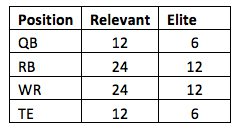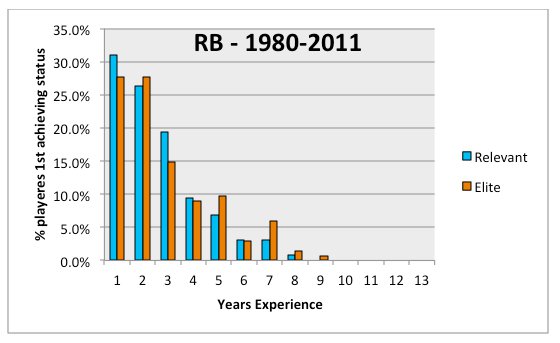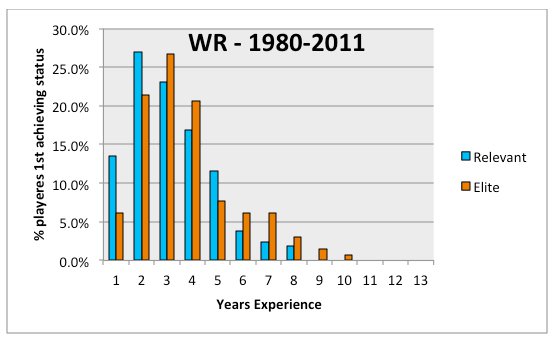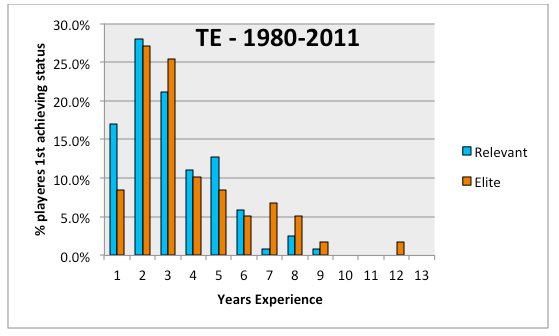I Can’t Quit You

Editor’s Note: This article is written by a new writer for DLF – Trevor Bucher. We’re excited to have Trevor and look forward to seeing his work here in the future!
Patience is a virtue in dynasty football. When drafting rookies and acquiring young players, we all know the risks involved. Many of them won’t pan out fully. Some will bust. Others, however, will become superstars. Nothing is more frustrating than drafting a player because you believe in him, watching him do nothing for three years, then trading him away or dropping him because “obviously he’s a bust”… then the next thing you know he’s a WR2 and his ADP shot up into the fourth round. How long is too long to hold onto a player? What is a reasonable amount of time within which to expect a return on investment? These are questions that can be taxing on dynasty owners. Well, I put together some numbers and shiny charts to give you a leg up on the competition.
How long is too long?
The intent of this research is to identify the years in which players have historically achieved one of two levels of success for the first time, defined by their years of experience. For our purposes, year one correlates to their rookie year and, yep, you guessed it, years two through whatever represent the rest of the years in a given players NFL career. For these purposes, relevant is defined as being a “startable” asset in a standard 12 team PPR league for non-flex slots. Elite is defined as being a top half option at the position among the startable assets. To qualify, a player has to reach or exceed the year-end ranking in the table below to meet each designation.
[am4show have=’g1;’ guest_error=’sub_message’ user_error=’sub_message’ ]

OK, so what?
Let’s dive into some historical data. For the purposes of this exercise, I looked at rookie players from 1980 to 2011. There have been qualifiers from 2012-2014, but the data would be too heavily skewed towards the front of the players’ careers since they haven’t even played their fourth season yet. Please keep in mind all percentages presented are relative to their designation in my system of Relevant and Elite. They do not represent a percentage of total NFL players.
So, for all players from 1980-2011, here is a visual breakdown of the years we can expect players to first become relevant or elite.

A whopping 80.9% of players who will ever become relevant will have done so by their fourth year, and that number jumps to 90.4% by year five. If you’re holding onto a player hoping their new surroundings on a second contract will pay off, you must be aware the odds are stacked against this ever happening. The most notable recent examples of late career explosions come from Brandon Lloyd, Fred Jackson, Justin Forsett and Martellus Bennett. How many dynasty owners were clinging to these players by the time they finally broke out? It does happen, but it just isn’t common. The numbers are pretty similar for Elite designations – 74% of players who will reach elite status will have done so by their fourth season, going up to 88.3% by year six.
However, just looking at a blanket study of all players is an inexact science. Some positions do prove to take longer to master than others, skewing the data towards later years for first instances of relevant and elite production.
The Quarterbacks

Quarterbacks show a tendency to become relevant and elite at a higher rate in later years than the overall population of NFL skill position players. Only 5.6% of quarterbacks who have registered a relevant season did so in their rookie year – that’s just five players from 1980-2011 out of 90 qualifiers. Quarterbacks are not a wise investment for immediate production. There is a bright side, though, as 73.3% of quarterbacks who become relevant will have done so by their fourth season. The numbers for elite also indicate it might be a long wait, with only 75% of first qualifying seasons having occurred by year five.
The good news?
If you hit on a quarterback, you are likely to have hit it big. Two thirds of quarterbacks who have relevant seasons also have at least one elite season under their belt – that’s the highest correlation between being relevant and being elite among the positions evaluated.
The Running Backs

Wow.
We have all heard running backs can really hit the ground running in the NFL, but this is a pretty eye opening chart. A whopping 76.7% of running backs who will register a relevant season will have done so by year three. By year four, we’re looking at 86.2%. Elite numbers are equally astounding, as 70.1% who will ever reach elite status will have done so by year three, going up to 79.1% after year four. Statistics are on your side, here, if you want to give up on a running back after year three.
Pump the brakes, though, because running backs have a low correlation from being relevant to being elite compared to quarterbacks and wide receivers – only 57.8% of players who are relevant will ever become elite.
The Wide Receivers

Compared to running backs, the idea receivers take longer to develop is indeed true. There is a pretty low chance of a wide receiver having even a relevant rookie season (2014 is an outlier). Only 13.5% of rookie wide receivers have been relevant historically, with 6.1% being elite. The big takeaway here is the steep fall off from year four to year five for elite wide receiver qualifiers. The decline in numbers is more steady from four to five for relevant qualifiers, but it drops from 20.6% qualifying as elite in year four to 7.6% qualifying in year five. If your goal is to own an elite wide receiver, they will need to have done it by year four or the odds are stacked against them ever getting to that level. 91.8% of wide receivers who will ever become relevant have done so by year five.
So, if a wide receiver has broken out by year four, can we expect consistency? It appears so, with 63% of wide receivers who ever qualify as relevant having also been elite for at least one season.
The Tight Ends

Tight ends are pretty similar to wide receivers. Very few succeed in year one, but those who will succeed tend to have done so by year three or four. The cliff from year four to year five is not as clear, with relevant qualifiers actually increasing from year four to year five. Some cut offs to watch here are the fact 89.8% of tight ends who will be relevant will have done so by year five and 79.7% of tight ends who will be elite will have done so by year five.
The eye popper for tight ends is only 50% of tight ends who have registered a relevant season have registered an elite season – by far the lowest correlation between the two among skill position players. The tight end landscape right now is apparently representative of the past, as the top tier is dominated by the truly elite and the rest of the pack comes and goes.
That was a lot of numbers and stuff. Just tell me what I need to know.
Okay, fine. If you want to ignore everything laid out above, just remember the odds of any given player becoming worthwhile to your fantasy roster after their fourth season is pretty low. If they have been in the league four years and not been a top 12-24 player yet, there is a pretty strong chance they will never become relevant. Hold onto your players through their fourth season and see if they develop. For running backs, you may want to slide that number down to three, and for quarterbacks and tight ends you may want to slide that up to year five – but the differences are not extreme. After the appropriate amount of time has passed – it’s okay, you can give up on a player. History is on your side.
Data provided by DLF Forum user Telperion’s Football Data Warehouse
[/am4show]
- Sunday Morning Huddle: Week 15 - December 17, 2017
- Sunday Morning Huddle: Week 14 - December 10, 2017
- Sunday Morning Huddle: Week 13 - December 3, 2017


































































